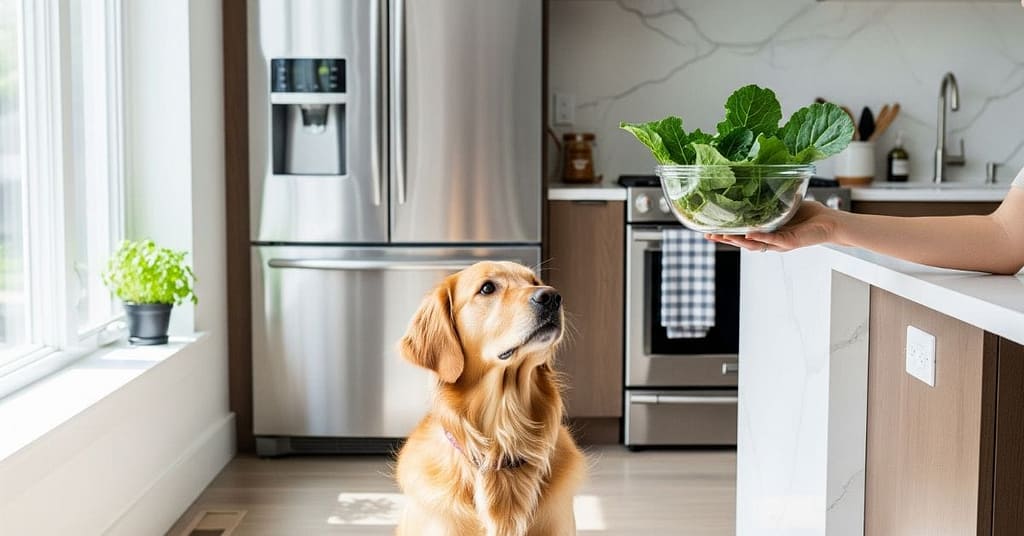Can dogs eat collard greens? I almost learned the answer the hard way. There I was, just last Tuesday, with a bundle of those dark, leafy greens on my chopping board. My golden retriever, Barney, was doing his best impression of a dog who hadn’t been fed in weeks, his nose working overtime at that earthy, green smell. I had a moment of that classic pet-parent guilt. Here I was, eating something super healthy, and he was just staring. So, I figured, “How bad could it be?” and my hand hovered with a small piece of raw stem.
Thank goodness I paused. A quick text to my vet friend- and a minor panic later- I realized I was seconds away from a potential nightmare. The truth is, the answer isn’t a simple yes or no. It’s a “yes, but…” and that “but” is huge. Based on the latest 2025 guidelines and a sobering chat with an expert, I’m breaking it all down for you. We will talk real benefits, real dangers ( like a scary rise in GDV cases linked to veggies), and the exact, safe way to do this if you decide to. Let’s get into the real story behind dogs and collard greens.

Why Would You Even Bother? The Potential Perks
Look, I get it. We see these leafy greens as a superfood for us, packed with good stuff. It’s natural to want to share that health kick with our four-legged friends. And when prepared with extreme caution, there can be some upsides.
- A Fiber Boost: A tiny amount of well-cooked collard green can act like a broom for your dog’s digestive system. It can help keep things moving smoothly and feed the good gut bugs, which is great for overall health.
- Vitamin Powerhouse: They are loaded with Vitamins A, C, and K. This means support for their eyesight, immune system, and healthy blood- pretty good for a leaf, right?
- The Diet Helper: For pups watching their waistline, a few pieces of this low-calorie green can be a way more satisfying treat than a boring old biscuit.
But here’s the thing nobody talks about enough: these benefits are completely overshadowed if you don’t prepare them exactly right. Which brings us to the critical part—the part that made me sweat in my kitchen.
The Single Biggest Risk Every Owner Needs to Know
This is the non-negotiable section. The most immediate danger with collard greens isn’t some obscure toxin; it’s something far more common and terrifying: bloat, or formally, Gastric Dilatation- Volvulus (GDV).
Here’s the deal. Collard greens are part of the cruciferous vegetable family (think broccoli, cabbage). They contain compounds that, in dogs, ferment in the gut and produce an insane amount of gas. I’m not talking about a little toot; I mean painful, stomach-distending gas.
For deep-chested breeds- Great Danes, German Shepherds, Weimaraners, Standard Poodles- this gas is the primary trigger for GDV. This is a life-threatening emergency where the stomach fills with air and then twists, cutting off blood flow. It’s a killer, and it can take a healthy dog in hours.
A friend of a friend, Lisa, learned this the hard way late last year. She gave her Boxer, Bruno, some leftover boiled cabbage from her dinner. She thought cooking it was enough. Within hours, Bruno was lethargic, his belly was hard and swollen, and he was trying to vomit with nothing coming up. It was a race to the emergency vet. Bruno survived, but the trauma- and the bill- stuck with her. She’s now militant about no gassy veggies. This isn’t a rare, one-off story; vets are seeing more of these cases.
Other Things to Keep in Mind:
- Thyroid Troubles: They contain goitrogens, which can mess with thyroid hormone production if fed in massive, regular amounts. It’s a big concern for dogs who already have thyroid issues.
- Kidney Stones: Oxalates in the greens can contribute to kidney stones in dogs already prone to them.
- Simple Tummy Aches: Even without full-blown bloat, the high fiber can cause diarrhea or serious discomfort if your dog isn’t used to it.
How to Do It Safely: The Only Method That Works
If you HAve read the risks and still want to proceed for your non-prone breed dog, this is the only way to do it. There is no room for creativity here.
Step 1: You MUST Cook Them.
I cannot stress this enough. Never, ever feed raw collard greens. Cooking is essential to break down those complex sugars that cause the horrific gas. Steaming is your best bet to preserve nutrients.
Step 2: Zero Seasoning. None.
This means no salt, no oil, no butter, and absolutely no onion or garlic (which are toxic). They must be utterly plain. The way we eat them is poison to dogs.
Step 3: De-Stem Completely.
Those thick, tough stems? They are a choking hazard and a nightmare to digest. Chop them off and toss them in the compost.
Step 4: Cool and Chop.
Let them cool down to room temperature. Then, chop the cooked leaves into tiny, manageable pieces. I’m talking small enough that there’s no chance of choking. Mix a minuscule amount into their regular food.
How Much is Okay? A Realistic Serving Guide
This is a treat, not a meal. The rule of thumb is that treats should only make up 10% of your dog’s daily calories. For collard greens, be even more conservative.
- Small Dogs (<20 lbs): Think a teaspoon, max.
- Medium Dogs (20-50 lbs): Maybe a tablespoon.
- Large Dogs (>50 lbs): A couple of tablespoons.
The most important step: Start with a piece the size of your pinky nail. Wait 48 hours. Watch their energy, their belly, and their poop. If anything seems off, abandon the mission. It’s not worth it.
Honestly? Here Are Safer Alternatives
After my kitchen scare and doing all this research, I’ve decided collard greens are more trouble than they’re worth for Barney. Why risk it when there are amazing, safe alternatives that don’t keep me up at night?
My Go-To Veggie Treats Now:
- Green Beans: Frozen or fresh, they’re crunchy, low-cal, and dogs love them.
- Cooked Sweet Potato: Pure bliss for them. Full of nutrients and easy on the stomach.
- Pumpkin (100% pure canned): The ultimate magic bullet for upset dog tummies.
- Carrots: Perfect for chewing and great for their teeth.
- Cucumber Slices: Basically, crunchy water. Awesome for hydration.
The Bottom Line
So, can dogs eat collard greens? Technically, yes. But the more honest question is: Should they?
For most dogs, the benefits are minimal and easily obtained from safer sources. For owners of deep-chested breeds or dogs with any health issues, the answer is a hard no. The risk of GDV is a nightmare I wouldn’t wish on anyone.
Trust your gut. If you’re hesitating, just grab a green bean instead. Your dog will love you for the treat, and you’ll love the peace of mind.
See Also: Can Dogs Eat Scooby Snacks? Unveiling the Mystery of the Beloved Treat
FAQs
Q1. Can I give my dog raw collard greens as a chew?
Absolutely not. Raw collard greens are tough, difficult to digest, and a major choking hazard. They also cause severe gas.
Q2. What are the immediate signs of a problem after they eat one?
Watch for a swollen or hard belly, restlessness, drooling, or trying to vomit without producing anything. These are red flags for bloat—get to a vet immediately.
Q3. Are the stems okay if I cook them?
Nope. Even cooked, the stems are too fibrous and can cause blockages. Always remove them completely before serving.
Q4. How often is too often for this treat?
This should be a rare, occasional thing. Once a week at most, and only if your dog has handled it perfectly before.
Q5. My dog has a sensitive stomach. Should I try this?
I wouldn’t. If your dog’s stomach is easily upset, introducing a known gassy vegetable is asking for trouble. Stick with bland, safe options like pumpkin.



